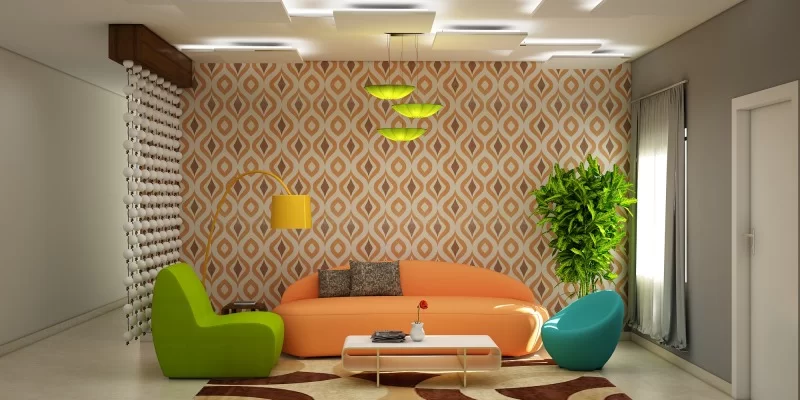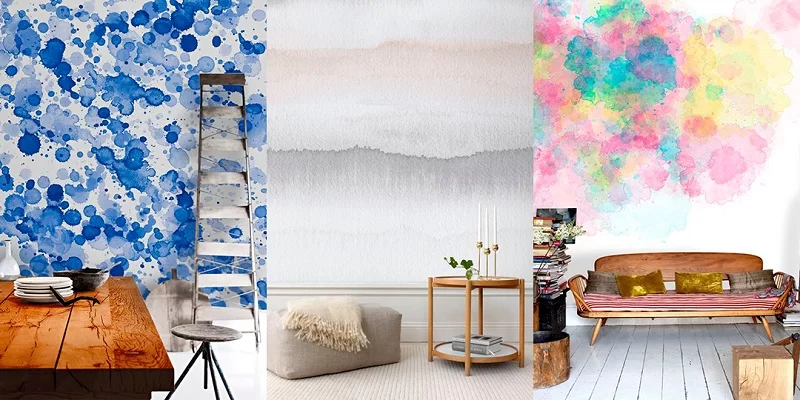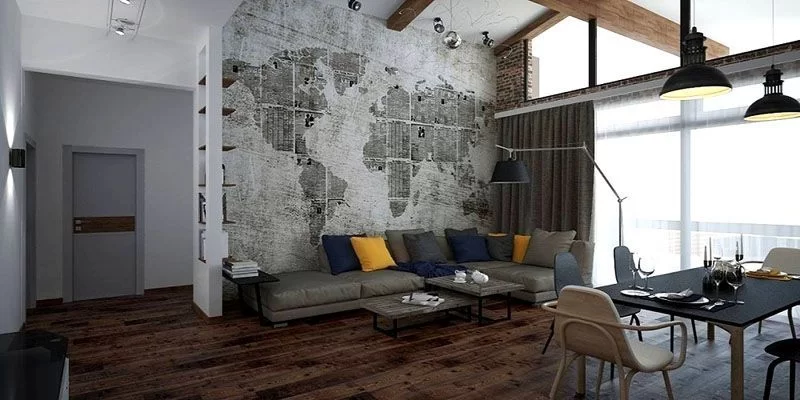
Compare liquid and ordinary wallpaper
Our experts in the field of construction and repair examined the features and properties of two types of wallpaper — ordinary and liquid, made a comparative analysis of their advantages and disadvantages, which will help you make an informed choice in favor of one or another material.
Ordinary wallpapers

Manufacturers produce many varieties of wallpaper, which can be divided into the following categories depending on the materials from which they are made:
-
paper;
-
non-woven;
-
vinyl;
-
textile;
-
fiberglass;
-
coated with natural materials;
-
metal.
paper wallpaper
The most popular type of this roll finishing material. They are divided into three types: simplex, duplex and for coloring.
Simplex wallpapers are made from a single layer of paper canvas with coloring and applying a simple pattern in a typographical way.
Duplex — are made from two or three interconnected layers of paper, which are coated with special compounds to impart moisture resistance and color stability. Then on one side with the help of rotational printing and using stencils, thickly rubbed ink is applied. The surface of the web material can be smooth or embossed, which is obtained by extruding a variety of patterns when rolling paper through rollers with an embossed surface.
Roll materials for painting consist of two or three layers of paper, which is impregnated with a special water-repellent compound, the surface is white and may have an embossed or coarse-fiber structure. An embossed surface is obtained by squeezing out various patterns; coarse-fiber wallpaper for coloring is made with the addition of wood chips to the composition. Materials for painting can be painted and repainted many times — from 5 to 15 times.
non-woven
They are made on the basis of interlining — a non-woven material, which is a mixture of natural and synthetic fibers. They can have a smooth or textured surface, which is given to this roll material using hot stamping. A variety of non-woven wallpaper can be used for painting.
Vinyl
They consist of two layers — the bottom layer is non-woven or paper, on which a thin layer of PVC (polyvinyl chloride) is applied, after which embossing or drawing is done. The bottom layer is impregnated with a special composition that protects against the appearance of fungus or mold.
A variety of vinyl materials includes silk screen printing, where a layer of vinyl with silk threads is applied to the bottom layer of paper, imitating pure silk fabric.
Other varieties of this type of material are foamed vinyl, embossed wallpapers imitating natural stone or ceramic tiles, and polyplene.
Textile
They are a paper base on which fibers of artificial or natural fabrics are glued — cotton, linen, silk, jute, viscose, etc.
fiberglass
They are made on the basis of fiberglass, which is produced from natural raw materials, including quartz sand, dolomite, soda and lime. They can consist of one layer or two layers — in this case, the fiberglass is glued to the paper backing. An embossing is made on the surface, giving a different kind of relief texture in the form of rhombuses, matting, Christmas trees, etc. Designed for subsequent painting with water-based or latex paints, and can withstand more than 10 repainting procedures.
Wallpaper coated with natural materials
With a paper base on which a thin layer of natural materials is glued, such as cork, bamboo, cane, natural wood veneer. They are used to create original interiors in the style of «country», «oriental», «ethnic», etc.
metal
They consist of a paper base on which a thin layer of metal foil is glued, then drawings or embossing are applied. They are vapor-tight, so they should only be applied to surfaces that absorb moisture well.
The liquid wallpaper

They are a dry mixture, which is diluted with water before use and then applied to the walls like plaster using spatulas, graters, rollers or special pistols. The mixture may include: cotton and cellulose fibers; waste from the woodworking and textile industries; waste paper; decorative elements — acrylic dyes, silk fibers, sparkles, mineral chips, etc.; adhesive compositions; antiseptics. Liquid wallpaper is also produced in the form of ready-to-use solutions sold in buckets.
Ready-to-use dry mixes or mortars are suitable for use by unskilled performers. For professional work, mixtures of white color and without decorative elements are produced, used in the creation of exclusive design projects for interior design. In this case, before use, the necessary dyes and decorative elements are added to the white base in accordance with the decisions of the design project.
They are divided into several main types: silk — with a predominance of silk fibers; cellulose; cotton; mixed type — with a combination of fibers of other types, silk-cellulose or silk-cotton.
Table of advantages and disadvantages
|
|
|
|
|
|
+ relatively low price;
+ ease of work on pasting walls;
+ environmental friendliness, as they are made from natural materials;
+ allow the walls to “breathe”, maintaining a healthy microclimate in the premises;
+ a wide choice of colors and patterns;
+ duplex wallpapers hide wall surface defects well, are resistant to moisture, temperature changes;
+ wallpaper for painting hides wall defects well, before pasting they do not require special preparation for leveling, they are not afraid of moisture;
+ can be used in almost any room, except for those operated with a high humidity regime.
|
— low strength;
— can fade under the action of solar ultraviolet radiation;
— low moisture resistance of simplex wallpaper;
— short service life;
— simplex wallpaper does not hide the imperfections of the wall surface, careful preparation and alignment is required before sticking;
— low resistance to mechanical stress.
|
|
|
+ have increased strength;
+ can be glued directly to the wall covered with glue, without applying glue to the roll;
+ not subject to shrinkage after the glue dries;
+ resistant to moisture;
+ well hide the defects of the surface of the walls, do not require special preparation of the base;
+ environmentally friendly, do not emit any harmful substances;
+ vapor-permeable, which is important for maintaining a healthy indoor climate;
+ not flammable;
+ do not fade in the sun.
|
— high price;
— textured wallpaper can accumulate dust;
— subject to mechanical damage.
|
|
|
+ have high strength;
+ high resistance to mechanical stress;
+ resistance to moisture — can be washed;
+ durability;
+ well hide the imperfections of the surface of the walls, do not require special preparation and leveling of the base;
+ resistant to solar ultraviolet;
+ good heat and sound insulation properties.
|
— do not let steam and air through, therefore it is not recommended to use this type in living rooms;
— insufficiently environmentally friendly, so synthetic materials are used in the manufacture.
|
|
|
+ differ in a wide variety of textures, colors, patterns;
+ invisible joints between the canvases;
+ good heat and sound insulation qualities;
+ not flammable;
+ resistant to solar ultraviolet, do not fade;
+ durability;
+ well hide the defects of the surface of the walls, do not require special preparation of the base;
+ some types, for example, jute can be dyed;
+ can be dry cleaned with a vacuum cleaner;
+ ecological purity, do not emit any harmful substances;
+ do not require adjustment according to the pattern, which facilitates the sticker procedure.
|
— high price;
— afraid of moisture;
— able to accumulate dust on the surface.
|
|
|
+ have increased strength, at the same time elastic, which makes them resistant to deformation;
+ not flammable — they are classified as hardly flammable materials;
+ durable;
+ vapor permeable;
+ have water-repellent properties;
+ environmentally friendly, as they are made from natural materials;
+ well hide wall defects, do not require special surface preparation;
+ have a wide variety of surface patterns;
+ easy to clean;
+ can be glued to the surface of any material.
|
— relatively high cost;
— require a large amount of paint;
— when replacing, they are difficult to tear off the walls.
|
|
|
+ environmental friendliness, as they are made exclusively from natural materials;
+ do not electrify and do not attract dust;
+ good heat and sound insulation properties;
+ allow you to create original interiors;
+ durable;
+ vapor permeable;
+ amenable to any type of cleaning;
+ can be used in rooms with a high humidity regime.
|
— require highly qualified performers when finishing;
— do not hide the surface defects of the walls, so careful preparation and leveling of the base is necessary before sticking;
— poor maintainability.
|
|
|
+ a rich choice in color and texture, which allows you to use the material to create interiors in any style;
+ ease of use — finishing work can be done by non-professionals. It is not required to select a pattern and join the seams;
+ lack of seams;
+ can be applied on surfaces made of any materials;
+ well hide wall defects, do not require special surface preparation;
+ the material is vapor-permeable, so it can be used in residential areas;
+ excellent heat and sound insulation qualities;
+ the ability to finish any complex surfaces — curved walls, arches, columns, etc.;
+ good maintainability — the damaged area can be easily cleaned and covered again with a layer of liquid wallpaper;
+ do not fade in the sun;
+ are not afraid of changes in temperature and humidity;
+ environmental friendliness, made mainly from natural materials;
+ durability;
+ antistatic — do not collect dust;
|
— long drying time, which can reach 5-6 days;
— relatively high cost compared to conventional wallpaper;
— able to soak with abundant soaking.
|

The main differences between materials
The main differences between the materials are as follows:
-
in the method of application;
-
maintainability — liquid wallpaper is easier to repair, if necessary, replaced without damage to the appearance of individual damaged areas;
-
with the help of liquid wallpaper, you can finish surfaces of any shape in the most inaccessible places, unlike rolled materials;
-
liquid wallpaper is elastic, unlike rolled materials, which is important when the building sags after finishing work.
What is the similarity of materials
The similarity of materials is as follows:
-
both types can be used to decorate rooms of the same functional purpose;
-
ease of finishing work — both types of materials can be used in work by unskilled performers;
-
a wide choice of finishing of both materials — colors, textures.
Conclusions: An unequivocal answer to the question: what is better — liquid or ordinary wallpaper cannot be given, since there are many varieties of both materials that have their own advantages and disadvantages and are suitable for use in different conditions. When choosing, the following criteria should be taken into account: the functional purpose of the room, the nature of the interior design, the mode of operation in terms of changes in humidity and temperature, and financial capabilities.
Добавить комментарий
Для отправки комментария вам необходимо авторизоваться.